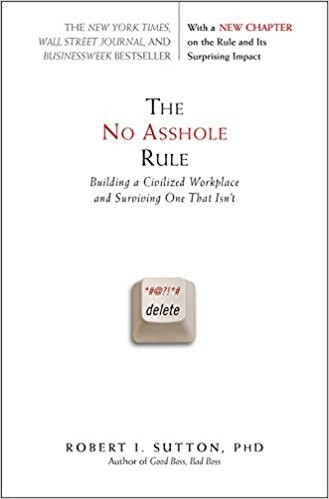
The topic this week in my Agile class was about leadership. During this week’s class discussion, the instructor pointed out to a book called “The No Asshole Rule” by Robert Sutton. I was intrigued by the bold name of this book. It’s not that common to find the word “asshole” as part of the book title. So I did a little research on the internet and it turns out that this book was actually quite popular when it was published back in 2007 by Robert Sutton, a professor at Stanford University. After reading through a few sample pages, I decided to buy the book and read it over the weekend. Here are a few things I find interesting.
The first few chapters of the book talks about what constitute someone as an asshole and how damaging it can do to an organization. The first step is to identify the actions of an asshole which the author listed out in his “The Dirty Dozen” list.
1. Personal insults
2. Invading one’s “personal territory”
3. Uninvited physical contact
4. Threats and intimidation, both verbal and nonverbal
5. “Sarcastic jokes” and “teasing” used as insult delivery systems
6. Withering e-mail flames
7. Status slap intended to humiliate their victims
8. Public shaming or “status degradation” rituals
9. Rude interruptions
10. Two-faced attacks
11. Dirty looks
12. Treating people as if they are invisible
Assholes are really people who are rude and show no respect for others. They don’t necessary has to be someone in a superior role. They can be very detrimental to organizations because they sap people of their energy and self-esteem. They make people feels like they are worthless. Plus, “assholeholics” as the author put it, is a disease that is very contagious. It can make other decent people around them turn into assholes over time. The organization should do anything it can to prevent this from spreading through the organization from not hiring an asshole to start off with to stopping it right away when it happens.
The author then talks about how to apply it to yourself and prevent the “Inner Jerk” from getting out from yourself. I was must interested in the self-test that the author provided in the book to give people a test to see where they stand on the spectrum. The test was divided into three sections: what are your gut reactions to people, how do you treat other people, and how do people react to you. Some red flags in the first set of questions include treating your coworkers like competitors and pushing them out or down to get to the top. The second set of questions deal with how you treat others and some red flags here include treating people like idiot and quick to blame others for mistakes. The final set of questions include how others react to you and some red flags here include other being very conscious around you or trying to avoid you all the time. Most of the questions revolve around whether you make others feel oppressed, humiliated, and belittled. Assholes make people feel terrible about themselves because they feel like they can.
When I went through the test, I failed some of the questions on the list but there is some good news. It’s actually normal for people to violate the rule once in a while. We are put under pressure at work and sometimes the pressure brings out the worst in us. I’m guilty of vetting my frustration on other from time to time because we don’t see eye to eye on some issues. It’s good to know that there are different levels of being an asshole. To be a “full-blown certified asshole”, you actually have to act like one all the time. I’ll try not to put myself in that category.
Assuming that you are not an asshole, the rest of the book goes on to talk about what you can do to put up with them. Here is a list of what the author suggest you can do.
1. Reframing: Change How you See Things
2. Hope for the Best; Expect the Worst
3. Develop indifference and Emotional Detachment
4. Look for Small Wins
5. Limit Your Exposure
6. Build Pockets of Safety, Support, and Sanity
7. Fight and Win the Right Small Battles
One thing I learn from life experience is that it’s really hard to change someone. If that someone really want to change, they have to want to change and actually change on their own terms. The best thing to do is not let them get to you. Distance yourself from them and look for ways to emotionally detach yourself from them. But in certain cases, you should definitely stand up and expose them.
So going back to how does this book relate to leadership traits required in Agile software development? The Agile process is about working closely with people. A lot of the time, it not only about how well you know about your technical domain, but rather it’s about your soft skills – your skills in working with people. If you want to be effective in Agile development, you should probably try not to be an “asshole”. A little respect and decency towards people goes a long way.
Comments